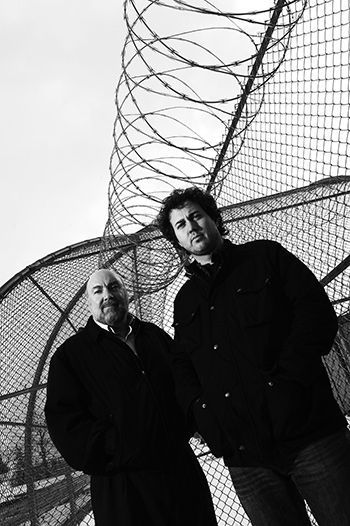
Written by Kellye Carter Crocker
Photo by Duane Tinkey
Think “public art,” and razor wire, electric fences and armed guard towers probably don’t pop immediately to mind. But Iowa’s two new prisons—still under construction at Mitchellville and Fort Madison—will soon welcome large public artworks designed by TJ Moberg and Dennis Reynolds and installed by inmates.
The $400,000 project will involve a diverse set of works, including sculptures, a mural and installations. Although Iowa prisons have a long history of displaying artwork, the new pieces will be the largest the system has developed, says John Baldwin, director of the Iowa Department of Corrections (DOC). What’s more, this is the first time offenders are assisting with design and installation, he says.
Though the works will be new, they’ll feature plenty of old items. For example, art pieces at the new Iowa State Penitentiary, which will be a maximum-security prison in Fort Madison, will incorporate old death-row cell bars from the current, historic prison. That prison—also in Fort Madison—opened in 1839 and is the oldest operating prison west of the Mississippi River, according to Brad Hier, deputy director of administration for the DOC.
“We’re going to clean (the cell bars) up, cut them into different shapes, powder-coat them and give them new life,” Moberg says. Reynolds adds that he and Moberg aim to repurpose as many items from the hulking limestone prison as possible, such as guard-tower spotlights, a “cool” fire hose rig and a furnace door with “a rugged, strong pattern.”
“It’s good for the environment,” Reynolds says, “and it creates another layer of meaning.”
“We’re all about the narrative,” Moberg adds.
After three years of meetings, planning, designing and other work, Reynolds and Moberg are eager to dig into the construction phase of the project this summer. “Because the new prisons are located within the city limits of Mitchellville and Fort Madison, the department anticipates that our new artwork will become an important part of the community landscape,” Baldwin says. “Initial public reaction to the artists’ designs has been positive.”
From the beginning when Moberg pitched the idea to the DOC, he wanted offenders involved in creating the artwork. In many places, that might mean grabbing a brush for a paint-by-numbers type of mural, Moberg says. But as he and Reynolds learned about the impressive quality of the Iowa Prison Industries program, which trains offenders in job skills such as woodworking, welding and stonework, their designs changed and grew. Involving offenders in art creation and installation also provides them with practical training and work experience as well as a sense of accomplishment, Reynolds says.
Iowa law requires that new state projects spend 0.5 percent of the construction cost on public art, but Moberg and Reynolds say they are able to do bigger projects because many of their supplies and the labor have been donated. The new $140.6 million Fort Madison prison is scheduled to open next January, and the Mitchellville prison, with a price tag of nearly $91 million, will move offenders to new buildings from this August through February 2014, Hier says.
Moberg and Reynolds acknowledge that, given the difficult economy, some Iowans may balk at using public money—even a small percentage—to pay for public art, particularly at prisons.
But, Reynolds asks, “Why not prisons?” Offenders deserve to enjoy the benefits of art as much as anyone else, he says. “Art makes us better people, whether you’re an offender or a non-offender” he says. “Your environment affects your emotions and how you feel about yourself and others around you.” Such projects can show offenders “they have worth to society,” Reynolds adds.
Besides, Moberg says, “85 percent of them are going to be set free back into society.”
The Project
Aluminum Sculpture
Clusters of undulating, intertwining aluminum ribbons—some up to 8 feet tall—will greet visitors and staff along the entrance drive to the new Iowa Correctional Institute for Women in Mitchellville, northeast of Des Moines. The bright pink, purple and silver ribbons will rise from a flowing, plant-filled terrain, says Reynolds, who also is a landscape architect. “The ribbons
will kind of emerge from the landscape and the plants,” he says, “and vice versa.” The ribbon motif will continue inside the lobby.
Offenders in a welding program at the minimum-security North Central Correctional Facility in Rockwell City created a steel prototype for the project, Moberg says. “They have a lot of pride in that ribbon,” he says. “The quality of the welding is pretty good.”
Possibly a Public Park
Moberg and Reynolds also have suggested that the ribbons area include a new park for prison staff and the Mitchellville community, incorporating a stream, wheelchair-accessible nature trails, benches and parking. The DOC’s Hier says that’s one of the options under consideration.
A Private Garden Courtyard
Inside the women’s prison, an outdoor garden area will replace the greenhouse and gardens lost to new construction. Located just outside the cafeteria and open only to offenders and staff, the courtyard will offer wheelchair accessibility and benches. “Even if you’re not actively gardening, you’re still getting the benefit of it,” Reynolds says. “What’s important is the whole idea of ‘sowing a seed’—make a positive effort and good things happen.”
The area will feature three large steel lattice trellises, where decorative vines will be encouraged to grow. The trellises, to be fabricated by inmates at Anamosa State Penitentiary in eastern Iowa, act as doorways into and through the garden, emphasizing an important theme—passing through a “threshold,” Reynolds says. “Hopefully, in their life there, they (the offenders) are going through changes, transformation,” he says. Offenders also will build a stone wall around the courtyard. Iowa State University landscape architecture students, who have spent years working on the overall prison plan, will help design the garden.
Limestone Monoliths
At the new prison in Fort Madison in southeast Iowa, seven imposing stone structures will rise at the entryway, although from certain points it will appear as if there’s only one solid rock wall, Reynolds says. Inmates participating in the penitentiary’s stonemasonry program will construct the monoliths, which—in a nod to the old prison—will be made of Iowa limestone. “It’s the notion of pulling that history into it,” Reynolds says.
Echoing the “threshold” motif, the monoliths will feature rectangular, window-like cutouts. One design includes death-row cell bars jutting out of an open rectangle, juxtaposing symbols of confinement and freedom. The artists hope to mount old guard-tower spotlights inside the spaces for a bright burst of color, Reynolds says.
An Eclectic Outdoor Piece
More limestone structures and salvaged items from the old Fort Madison prison will form a rambling modern art piece along the front of the main administration building and entrance to the new prison. It will be similar to Moberg and Reynolds’ expansive and inspiring “Harmony Line” at the YMCA Healthy Living Center in Clive, which includes repurposed farm equipment. The stonework also will continue inside the prison lobby.
An Indoor Mural
A large, colorful mural, also created by offenders, is planned for inside the prison visitor waiting area at the new Fort Madison prison.












